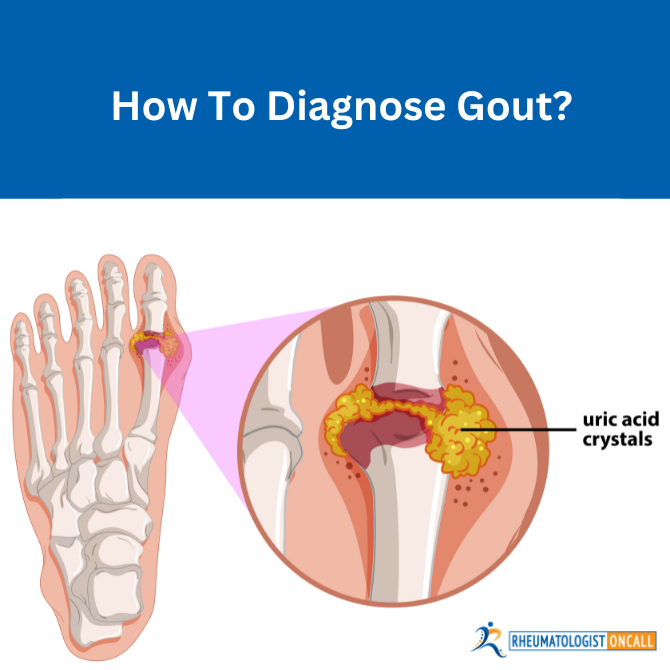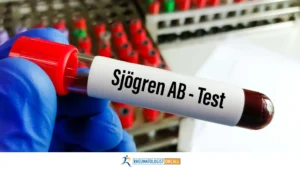SHARE
Setting the Stage: What is Gout?
As an experienced rheumatologist, I’ve had the privilege of treating numerous patients with gout at my practice, Rheumatologist OnCall. Before we delve into the diagnostic process, let’s set the stage with a quick review of gout. Gout is an inflammatory form of arthritis, triggered by an accumulation of uric acid crystals in the joints. While the big toe is often the primary target, gout can affect any joint, including the ankle, knee, or fingers. Gout typically presents itself with a sudden onset of severe joint pain. This pain can be so intense that even the weight of a bedsheet may feel unbearable. Often, this pain peaks within the first 4 to 12 hours.
After the initial onslaught of pain subsides, lingering discomfort often follows. This discomfort can last for several days or even weeks. Subsequent gout attacks may last longer and affect multiple joints.
The affected joint or joints may become swollen, tender, warm, and red. This is because gout causes inflammation, which leads to these symptoms. The skin over the affected joint might also appear shiny and start to peel. Being able to recognize these signs is crucial to ask for help.
Initial Recognition: Understanding Symptoms and Initial Assessment
When a patient comes to Rheumatologist OnCall presenting with symptoms suggestive of gout, we undertake a comprehensive assessment. This includes a detailed medical history, physical examination, and thorough symptom analysis. If you’re interested in understanding more about the signs and symptoms of gout, I recommend my blog post, “A Comprehensive Guide to Understanding Gout”.
A Closer Look: Laboratory Tests and Imaging
Once a suspicion of gout arises, we proceed with laboratory tests and imaging studies for confirmation:
Blood Tests
Blood tests serve as the cornerstone of gout diagnosis. A blood test measures uric acid levels, which can be heightened in the presence of gout. Simultaneously, we assess kidney and liver function, along with hemoglobin A1c, as gout often coexists with diabetes and kidney issues. Understanding these underlying conditions helps us manage your gout more effectively.
Synovial Fluid Analysis
Synovial fluid analysis is another crucial tool in diagnosing gout. We extract a fluid sample from the distressed joint with a needle and examine it under a microscope. The presence of needle-shaped, negatively birefringent uric acid crystals is a definitive indicator of gout.
Imaging
X-rays, ultrasounds, or CT scans provide a visual picture of the affected joint and help rule out other conditions that might mimic gout symptoms. For instance, patients with psoriasis or psoriatic arthritis often present with symptoms similar to gout.
Shining a Spotlight: CT Dual Energy in Gout Diagnosis
As medical technology advances, we’re able to leverage new tools and techniques to improve the diagnostic process. In the case of gout, one of the most significant recent advancements is the use of CT Dual Energy imaging.
What is CT Dual Energy?
CT Dual Energy is an advanced imaging technique that uses two separate X-ray beams to produce images of a patient’s body. The two X-rays have different energy levels, allowing them to capture more detail and provide clearer, more accurate images than a traditional CT scan.
How Does CT Dual Energy Work in Diagnosing Gout?
CT Dual Energy is particularly effective for diagnosing gout because it can visualize uric acid deposits in the joints. This is an important advancement because these deposits are not always seen in standard imaging tests. With the Dual Energy CT scan, uric acid crystals show up as specifically colored areas, making them easy to identify.
Here’s how it works: when the CT scan is conducted, the two X-ray beams pass through the body. The different tissues in the body, including uric acid crystals, absorb the X-rays to different extents. This variance in absorption allows the imaging software to differentiate between various types of tissues. In the case of gout, the uric acid deposits in the joints can be highlighted and analyzed.
Advantages of CT Dual Energy for Gout Diagnosis
The use of CT Dual Energy in diagnosing gout presents several advantages:
Accuracy: This technique provides highly accurate imaging of uric acid deposits, even when they’re not visible with conventional imaging techniques. This can be particularly beneficial for patients with inconclusive or conflicting results from other tests.
Non-invasive: CT Dual Energy is a non-invasive diagnostic method, meaning it doesn’t require any incisions or injections, making it a less uncomfortable and more patient-friendly procedure.
Speed: The imaging process is quick and efficient, which can aid in faster diagnosis and treatment planning.
Guidance for Treatment: By revealing the extent of uric acid crystal buildup, the scan can guide treatment decisions and help evaluate the effectiveness of a patient’s current gout management strategy.
While the use of CT Dual Energy in gout diagnosis holds immense promise, it’s essential to remember that this is one tool among several.

Drawing Conclusions: Confirming a Gout Diagnosis
We can confirm a gout diagnosis when uric acid crystals are detected in the synovial fluid or when typical symptoms coincide with elevated blood uric acid levels and positive imaging results. However, it’s vital to remember that only a healthcare professional can accurately diagnose gout.
Beyond diagnosis, managing gout involves lifestyle and dietary adjustments. For practical tips on controlling your gout symptoms through diet, watch my video, “The Best and Worst Foods for Gout.”
Conclusion: Your Partner in Gout Management
Understanding gout and its diagnostic process is the first step in managing this painful condition. If you suspect you may be suffering from gout, reach out to the expert team at Rheumatologist OnCall. We’re here to guide you through diagnosis and treatment, ensuring you’re not alone in your journey.














